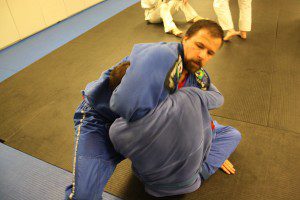Brazilian Jiu-Jitsu Self-Defense Strategy. Brazilian Jiu-Jitsu is a highly effective self-defense system. Unfortunately, BJJ’s self-defense applications are often ignored in today’s competition-focused environment. This isn’t meant to disparage BJJ competitions, as they’re a great way to test your skills and evaluate your progress. However, we should always keep in mind BJJ’s original purpose and devote at least a portion of our training to pure self-defense.
With this in mind, I believe that the ideal BJJ strategy should be one that is effective on both the mat and the street. Of course, the techniques and sequences you use in any situation will vary depending on the reactions of your opponent. If you keep these following general principles in mind, you should be well-prepared for any unarmed, one-on-one physical altercation.
5 Self Defense Ideas
1) Close the distance – One of the things that makes BJJ so effective is that most people know very little about ground fighting. It is for this reason that you should focus on taking your opponent to the ground as quickly as possible.
The first step in taking your opponent down is closing the distance. Most fights begin within striking distance of your opponent. In this distance you can strike your opponent and your opponent can strike you.
However, as a BJJ fighter, you shouldn’t be looking to engage in striking matches. Therefore, your initial goal should be to close the distance while avoiding your opponent’s punches and kicks. There are multiple ways to achieve this, and they should be drilled regularly.
2) Clinch – After closing the distance, you need to ensure that your opponent can’t strike you. This is where the clinch comes in. There are many variations of the clinch, but the most important thing to remember is that it’s a way of protecting yourself while controlling your opponent.
By tying up your opponent’s arms and staying close to his body, you take away his ability to throw strikes. Even if he manages to hit you from this distance, he won’t be able to generate enough power to do any real damage.

Takedown
3) Takedown – Once you’ve secured the clinch, you should be prepared to take your opponent to the ground. It’s for this reason that that all grapplers should master at least a few basic takedowns. After all, what good is ground fighting without the ability to actually put your opponent on the ground?
4) Advance position – Following the takedown, you should begin to advance position on your opponent. Occasionally, a takedown will result in an immediate advantageous position, but you will oftentimes be required to pass your opponent’s guard. Following the guard pass, you should continue to advance position maintaining control. By controlling your opponent each step of the way, until you are ready to end the fight with strikes or a submission.
5) Finish – The final step of this basic strategy is to finish the fight. There are multiple ways to finish your opponent from each of the dominant BJJ positions. The important thing to keep in mind at this stage is that you must maintain control of your opponent. In fact, this is a principle that must be adhered to in each of the preceding steps. BJJ is all about control, and if you don’t control your opponent every step of the way, his odds of escape increase significantly.
While there are multiple ways to approach BJJ, this tried and true strategy dates back to the earliest days of Brazilian Jiu-Jitsu. Bear in mind that while striking and strike defense are discussed above, this strategy can be modified. By using this idea both in competition and training, because the basic principles remain the same.



